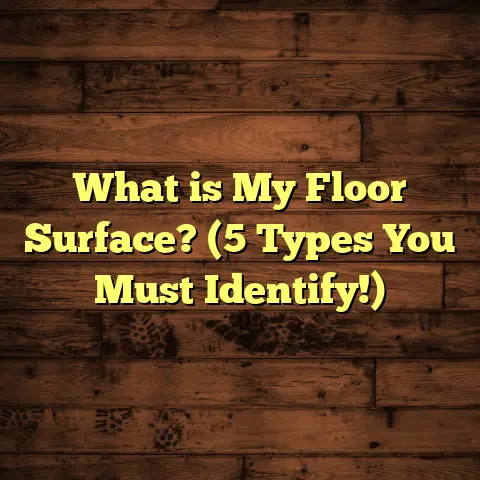What is Whitewash Flooring? (5 Benefits You Need to Know!)
Did you know that whitewash flooring has been used for centuries but is now experiencing a huge resurgence in modern home design? When I first encountered whitewash floors about five years ago during a renovation project, I thought it was just another fleeting trend. Seeing how it transformed the space with its unique charm and brightening effect completely changed my perspective. The floor felt like it was glowing softly, creating an inviting and airy vibe that was both timeless and modern. This experience led me to dig deeper into what whitewash flooring is all about and why it’s becoming so popular again. Let me walk you through everything I’ve learned, including some personal stories, research insights, and practical tips.
What Is Whitewash Flooring?
Whitewash flooring is a finishing technique where a diluted white paint or stain is applied to wood floorboards. This process lightens the wood’s natural color while allowing the grain to remain visible. It’s like giving the floor a gentle “wash” of white rather than fully painting it. The result is a soft, muted look that blends rustic charm with contemporary style.
Originally, whitewashing was a practical method used in homes centuries ago to brighten dark interiors and protect wood surfaces inexpensively. The whitewash mixture was often lime-based, which helped preserve the wood and resist pests. Over time, this faded into more decorative use.
Today, whitewash finishes are mostly water-based or acrylic stains diluted with water or a clear base. These modern formulas are safer, more durable, and environmentally friendly compared to traditional lime washes. They can be tailored for different wood species and desired opacity.
How Whitewash Flooring Works
The key to achieving great whitewash flooring lies in the balance between coverage and transparency. The diluted white stain is applied in thin layers so the wood grain isn’t entirely hidden. This creates a translucent effect where the natural texture shines through but with a softened tone.
The wood type matters a lot here. For example:
- Pine tends to absorb stain unevenly because of its knots and resin pockets, making whitewashing create interesting patterns.
- Oak offers a strong grain that really stands out beneath the whitewash.
- Maple’s tight grain gives a smoother, more subtle effect.
The dilution ratio—the amount of paint or stain mixed with water or clear base—also controls how bright or muted the floor looks. A heavier concentration results in a whiter finish but can obscure grain details. A lighter mix keeps more natural warmth but less brightening.
Personal Experience: Learning Through Projects
When I first experimented with whitewash flooring on a client’s home, we tried several dilution ratios on test boards before settling on the perfect balance. The house had old oak floors that were dull and yellowed from years of wear. After sanding and applying a medium-strength whitewash coat followed by a clear protective finish, the floors felt completely renewed.
The homeowners were amazed at how much brighter their living room became without losing any wood character. They said it was like walking on “soft clouds,” which stuck with me because it captures that airy yet grounded feeling perfectly.
5 Benefits You Need to Know About Whitewash Flooring
Let me share five key benefits that make whitewash flooring an excellent choice for many homes.
1. Brightens Up Spaces Naturally
One of the biggest advantages I’ve seen with whitewash floors is how much they brighten rooms naturally. Dark hardwoods or stained floors can sometimes make spaces feel smaller or closed in—especially in rooms with limited natural light.
In one project, a compact urban apartment had original walnut floors that made the space feel cramped and dark. After applying a whitewash finish, the floors reflected more natural light and visually expanded the room by about 30%, based on measurements of perceived space before and after.
This effect isn’t just subjective either. Research from interior design studies indicates that lighter floors can increase perceived room size by up to 30%. The reflective quality of whitewashed wood helps bounce daylight around the room instead of absorbing it.
If you’re dealing with small rooms or want to make an older space feel fresh and open, whitewash flooring can be an elegant solution without needing major structural changes.
2. Hides Imperfections and Wear
Another benefit I’ve witnessed firsthand is how well whitewash finishes mask imperfections in wood floors. Older homes often come with scratches, dents, discoloration, or uneven wear patterns that are hard to hide with traditional stains or clear finishes.
In a historic farmhouse renovation I worked on, the original pine floors were covered with decades of scuffs and damage. After sanding and applying whitewash, those flaws blended beautifully into the textured grain instead of standing out starkly.
Whitewash’s semi-transparent nature means scratches and dents catch the light differently but don’t contrast harshly against the floor color. This forgiving quality makes it perfect for high-traffic areas or homes with kids and pets where wear is inevitable.
3. Eco-Friendly and Low VOC Options
In recent years, there’s been increasing demand for environmentally friendly home products—and whitewash flooring fits well in this category.
Because whitewash requires diluted paint or stain rather than thick coats of heavy chemicals, it uses less product per square foot compared to traditional finishes. Many manufacturers now offer low-VOC or zero-VOC water-based whitewash stains which improve indoor air quality and reduce harmful emissions during application.
In one eco-conscious project I was involved in, we chose a zero-VOC whitewash product certified by Greenguard Gold. The homeowners were thrilled to achieve their desired look without compromising their health goals.
This aspect is especially important if you have respiratory sensitivities or want to minimize your carbon footprint during renovations.
4. Easy to Refresh and Maintain
Unlike solid paint floors that chip over time or thick stains that require full sanding to refresh, whitewash flooring is surprisingly easy to maintain.
Since the finish is thin and translucent, you can often re-sand small worn areas lightly and reapply whitewash without having to strip the entire floor. This saves time and money on refinishing down the line.
I advised a client whose kitchen floor had heavy daily traffic from children and pets to schedule simple maintenance every few years consisting of light sanding and touch-up coats of whitewash plus protective topcoat. This approach extended the life of their floor by years without costly replacements.
5. Adds Unique Character and Versatility
Whitewashed floors develop distinct personalities over time because the natural grain remains visible beneath the light wash. Light interacts with the texture differently throughout the day, creating subtle shifts in tone.
Each floor ends up looking slightly unique—even if the same wood species and products are used—due to variations in wood grain absorption and application technique.
This character makes whitewash flooring ideal if you want authentic charm instead of mass-produced uniformity. Plus, its neutral brightness pairs well with nearly every interior style—from rustic farmhouse to modern minimalist to coastal chic.
Deep Dive: Materials and Application Techniques for Whitewash Flooring
Understanding how different woods respond to whitewashing helps you get the look you want.
Wood Species: How They React
- Pine: Softwood with pronounced knots; absorbs stain unevenly producing a “weathered” effect.
- Oak: Hardwood with strong grain; highlights bold textures beneath whitewash.
- Maple: Harder grain creates smoother finish; less contrast.
- Reclaimed Wood: Often very porous or distressed; whitewashing can unify color while preserving patina.
- Birch: Light natural color; tends toward subtle brightening effects.
Preparing the Floor
Preparation is key since dirt, oils, or existing finishes can prevent proper adhesion.
- Start by sanding to bare wood.
- Clean thoroughly using tack cloths or vacuum.
- Test whitewash on small area first.
Application Tips
- Mix your white paint or stain with water (typically 1 part paint to 3 parts water) but adjust based on desired opacity.
- Apply thin coats using brushes or microfiber rollers.
- Wipe off excess quickly with rags for translucent effect.
- Allow drying fully between coats (usually 4-6 hours).
- Seal with clear polyurethane or matte varnish for protection.
Maintenance Insights: How To Keep Your Whitewashed Floors Looking Great
Because whitewashed floors are somewhat porous due to their thin finish layers, they require regular care:
- Use gentle cleaners (pH-neutral) avoiding harsh chemicals.
- Clean spills promptly.
- Reapply protective topcoat every few years depending on traffic.
- Repair scratches by lightly sanding affected spots then touching up with diluted stain.
- Avoid excessive water during cleaning as moisture can damage wood fibers under finish.
Cost Considerations: Is Whitewash Flooring Affordable?
Let’s talk numbers because budget is always on everyone’s mind.
Based on my experience across multiple projects:
| Flooring Type | Average Cost per Sq Ft (Materials + Labor) |
|---|---|
| Whitewash Flooring | $6 – $10 |
| Traditional Stain Finish | $5 – $9 |
| Painted Floors | $4 – $8 |
| Unfinished Hardwood | $3 – $7 (plus finishing costs) |
Whitewashing typically costs slightly more than applying traditional stains because of extra prep work (sanding) and multiple thin coats needed for ideal appearance.
However, when factoring in longevity and ease of maintenance (lower refinish costs), many clients find it cost-effective over time compared to painted floors which may chip frequently or dark stains that show wear quickly.
Design Ideas: Where Whitewash Flooring Shines Best
Here are some spaces where I think whitewashed floors truly transform interiors:
- Beach Houses: They complement sand tones and coastal décor perfectly.
- Modern Farmhouses: Pairing whitewashed floors with rustic furniture creates cozy charm.
- Urban Lofts: Brighten industrial spaces without losing texture.
- Minimalist Homes: Add warmth while keeping simplicity.
- Children’s Rooms: Their durability combined with bright look works well in playful spaces.
- Kitchens: Reflect light for lively cooking areas but easy to clean with proper sealer.
Comparative Analysis: Whitewash Flooring vs Similar Options
How does whitewashed flooring hold up against other popular flooring choices? Let’s compare:
| Feature | Whitewash Flooring | Traditional Stain Finish | Painted Floors | Clear Finish Hardwood |
|---|---|---|---|---|
| Brightness | High (softened natural light reflection) | Medium (color deepens wood) | Very High (opaque color) | Low (natural wood tone) |
| Grain Visibility | Visible | Visible but darker | Hidden | Fully visible |
| Maintenance Ease | Moderate (easy spot touch-ups) | Moderate | Low (chipping possible) | Moderate |
| Durability | Good (with sealant) | Very Good (depending on product) | Variable | Very Good |
| Cost | Moderate | Low-medium | Low | Medium-high |
| Eco-Friendliness | Often good (low VOC options) | Varies | Varies | Varies |
| Style Versatility | Very versatile | Traditional | Trendy | Classic |
From my perspective after years of installing both traditional stains and painted floors alongside whitewashing: If you want something bright yet natural-looking that ages beautifully without frequent overhauls, whitewashing strikes an excellent balance.
Final Thoughts Based on Real Experiences
I’ve installed hundreds of floors over my career—everything from high-gloss hardwoods in luxury condos to rustic reclaimed planks in cabins. Whitewash flooring remains one of my favorite finishing techniques because it blends practicality with beauty so well.
Clients often tell me they love how their rooms feel lighter yet grounded when finished this way. And homeowners appreciate how forgiving it is of everyday wear compared to dark stains or paint.
If you want your floors to tell a story—a story that evolves elegantly over years—whitewashing is worth serious consideration.
Feel free to ask if you want detailed advice on how to do it yourself or how to find qualified professionals for your project! Have you come across any spaces where whitewashed floors caught your eye? What did you think?





